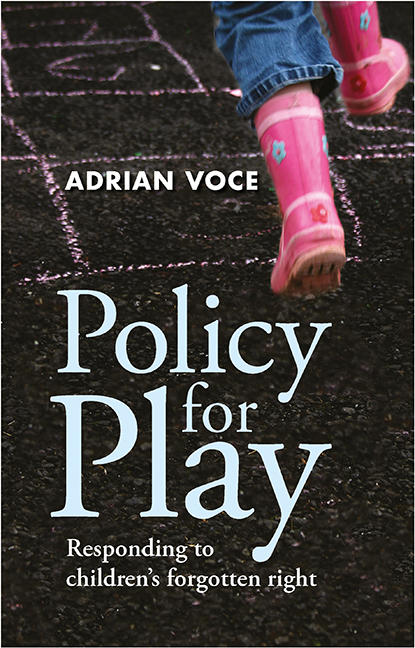Book contents
- Frontmatter
- Dedication
- Contents
- Who’s who
- About the author
- Preface
- Foreword
- Prologue
- Introduction ‘To respect, protect and fulfil’
- one ‘To play and to dream’ • Restoring play to the heart of the campaign for children’s rights
- two ‘For a change’ • Finding the evidence for play policy
- three ‘Advocates for play’ • Playwork’s place at the heart of the play movement
- four ‘New opportunities’ • Lottery funding and the beginnings of public play policy
- five ‘A vital and vibrant city’ • How devolved government in London set a benchmark for play policy
- six ‘Making the case’ • The call for a national play strategy
- seven ‘Things to do, places to go?’ • How play was overlooked by children’s services reform
- eight ‘Getting serious’ • The national play review
- nine ‘Lottery millions’ • The Children’s Play Initiative
- ten ‘Dirt is good’ • The Play England project
- eleven ‘The best place in the world’ • The Play Strategy for England
- twelve ‘Playbuilders’ • Breaking the mould of the public playground
- thirteen ‘Everyday adventures?’ • Austerity brings an end to play policy in England
- fourteen ‘Skylarks and canaries’ • The legacy of the Play Strategy
- fifteen ‘Children now’ • Responding to children’s right to play: conclusions and recommendations
- Epilogue
- References
- Index
twelve - ‘Playbuilders’ • Breaking the mould of the public playground
Published online by Cambridge University Press: 08 March 2022
- Frontmatter
- Dedication
- Contents
- Who’s who
- About the author
- Preface
- Foreword
- Prologue
- Introduction ‘To respect, protect and fulfil’
- one ‘To play and to dream’ • Restoring play to the heart of the campaign for children’s rights
- two ‘For a change’ • Finding the evidence for play policy
- three ‘Advocates for play’ • Playwork’s place at the heart of the play movement
- four ‘New opportunities’ • Lottery funding and the beginnings of public play policy
- five ‘A vital and vibrant city’ • How devolved government in London set a benchmark for play policy
- six ‘Making the case’ • The call for a national play strategy
- seven ‘Things to do, places to go?’ • How play was overlooked by children’s services reform
- eight ‘Getting serious’ • The national play review
- nine ‘Lottery millions’ • The Children’s Play Initiative
- ten ‘Dirt is good’ • The Play England project
- eleven ‘The best place in the world’ • The Play Strategy for England
- twelve ‘Playbuilders’ • Breaking the mould of the public playground
- thirteen ‘Everyday adventures?’ • Austerity brings an end to play policy in England
- fourteen ‘Skylarks and canaries’ • The legacy of the Play Strategy
- fifteen ‘Children now’ • Responding to children’s right to play: conclusions and recommendations
- Epilogue
- References
- Index
Summary
In North London, less than half a mile away from the noise and pollution of the Archway roundabout on the ever-congested A1, some children are looking for refuge. Living on the sprawling social housing estates that sit uncomfortably close to this unceasing melee of traffic, commuters and employees of the various welfare agencies housed by the forbidding Archway Towers, they head for the idyllic Waterlow Park, situated halfway up the steeply inclining road that connects their own working class inner-city neighbourhood to the affluence of nearby Highgate.
Waterlow Park is one of the many historic parks and gardens that set London apart from many other large capital cities. Situated close to the expanses of Hampstead Heath and tucked away between the imposing arts centre of Lauderdale House on one side, and the famous Highgate Cemetery on the other, it is less well frequented than many and has a peaceful, secluded charm.
To these children from the Archway estate this place is – as Sydney Waterlow described when bequeathing it to the London County Council in 1889 – a ‘garden for the gardenless’: somewhere spacious and green, where they can play in relative freedom with their friends, away from the traffic.
There is an old children’s playground in Waterlow Park, next to the duck pond. Curiously, given that the park is located on a steep natural hill, the playground is flat and devoid of vegetation, with an asphalt floor except beneath the various pieces of standardised equipment, where there is a synthetic rubber-like surface designed to reduce the risk of harm in the unlikely event that children might fall from it. The equipment comprises two rows of three swings each, one for toddlers. There is a roundabout, a climbing frame and a seesaw, each made primarily of wrought iron painted in primary colours, now faded and peeling. It is typical of the many thousands of playgrounds built in Britain during the middle part of the 20th century and occasionally renewed to more or less the same template ever since. These children from Archway have long since stopped using it, discovering very quickly that there was more fun to be had simply exploring the undulations of the park or making up their own games in and out of its many wooded areas or around its ponds.
- Type
- Chapter
- Information
- Policy for PlayResponding to Children's Forgotten Right, pp. 117 - 124Publisher: Bristol University PressPrint publication year: 2015

